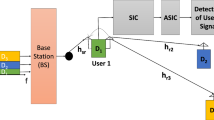Abstract
In this paper, we carry out performance analysis of a multiuser full-duplex (FD) communication system. Multiple FD user equipments (UEs) share the same spectrum resources, simultaneously, at both the uplink and downlink. This results in co-channel interference (CCI) at the downlink of a UE from uplink signals of other UEs. This work proposes the use of diversity gain at the receiver to mitigate the effects of the CCI. For this an architecture for the FD eNodeB (eNB) and FD UE is proposed and corresponding downlink operation is described. Finally, the performance of the system is studied in terms of downlink capacity of a UE. It is shown that through the deployment of sufficient number of transmit and receive antennas at the eNB and UEs, respectively, significant improvement in performance can be achieved in the presence of CCI.





Similar content being viewed by others
Notes
In this work, equal power allocation across all the Q streams and \(N_r\) streams is considered at the downlink and uplink, respectively.
The capacity here is defined as number of correct bits received per second per Hertz.
References
Ashutosh, S., Schniter, P., Guo, D., Bliss, D. W., Rangarajan, S., & Wichman, R. (2014). In-band full-duplex wireless: Challenges and opportunities. IEEE Journal on Selected Areas in Communications, 32(9), 1637–1652.
Bjorn, D., van den Broek, D.-J., Lavin, C., van Liempd, B., Klumperink, E., Palacios, C., et al. (2014). Analog/RF solutions enabling compact full-duplex radios. IEEE Journal on Selected Areas in Communications, 32(9), 1662–1673.
Goyal, S., Liu, P., Panwar, S., DiFazio, R., Yang, R., Li, J., & Bala, E. (2014). Improving small cell capacity with common-carrier full duplex radios. In IEEE International conference on communications (ICC), (pp. 4987–4993). IEEE.
Pradhan, C., & Murthy, G. R. (2015). Full-duplex transceiver for future cellular network: A smart antenna approach. In 2015 IEEE international conference on advanced networks and telecommuncations systems (ANTS) (pp. 1–6). Kolkata.
Eshwaraiah, H. S., & Chockalingam, A. (2013). SC-FDMA for multiuser communication on the downlink. In 2013 Fifth international conference on communication systems and networks (COMSNETS),, (pp. 1–7). IEEE.
Goldsmith, A. (2005). Wireless communications. Cambridge: Cambridge University Press.
Zheng, K., Zhao, L., Mei, J., Shao, B., Xiang, W., & Hanzo, L. (2015). Survey of large-scale MIMO systems. IEEE Communications Surveys & Tutorials, 17(3), 1738–1760.
Author information
Authors and Affiliations
Corresponding author
Appendix
Appendix
The noise and interference in the Eq. (6) is given by:
After removing the CP and converting it to the frequency domain, we have:
where \({\mathbf {H}}^u_{q,\acute{k},l,k} = diag({\mathbf {F}}_N {\mathbf {h}}^u_{q,\acute{k},l,k})\) is the NXN diagonal matrix whose diagonal elements are frequency domain coefficients between \(\acute{k}{\text{th}}\) transmit antenna of the \(q{\hbox {th}}\) UE and \(k{\hbox {th}}\) receive antenna of the \(l{\hbox {th}}\) UE. \({\mathbf {x}}^u_{q,\acute{k}}\) is the transmit signal from \(\acute{k}\) antenna of the \(q{\hbox {th}}\) UE. This signal is then subjected to the subcarrier deallocation and after simplifications, similar to Eq. (8), we get:
where \({\bar{\mathbf {I}}}_l (m) = [\bar{I}_{l,1}(m), \bar{I}_{l,2}(m),\ldots ,\bar{I}_{l,N_r}(m)]^T\), \({\mathbf {\alpha }}_q = diag(\alpha _q^{0}, \alpha _q^{1}, \ldots , \alpha _q^{N_r-1})\) and \({\mathbf {\bigtriangleup }} = diag(\bigtriangleup _1, \bigtriangleup _2, \ldots , \bigtriangleup _{N_r})\). \({\mathbf {H}}^u_{q,l} (m)\) is the \(N_r \times N_r\) frequency domain channel coefficient vector between the \(l{\hbox {th}}\) U and the \(q{\hbox {th}}\) UE on the \(m{\hbox {th}}\) subcarrier. This signal for \(k{\hbox {th}}\) antenna of the \(l{\hbox {th}}\) UE is given by:
Now, considering the fact that the \(\bar{n}_{l,k}(m)\) and \(H^u_{q,\acute{k},l,k}(m)\) are i.i.d, the power in the above signal is given by:
The signal is now subjected to post-processing from equation (10), .i.e, multiplying with \(({\mathbf {U}}^d_{m,l})^H\):
where \({\tilde{\mathbf {I}}}_l(m)=[{\tilde{I}}_{l,1}(m), {\tilde{I}}_{l,2}(m), \ldots ,{\tilde{I}}_{l,Q}(m)]^T\). As \(Q=N_r\) and \({\mathbf {U}}^d_{m,l}\) is an unitary matrix, we have \(|{\tilde{\mathbf {I}}}_l(m)|^2 = |{\bar{\mathbf {I}}}_l(m)|^2\). The power of the signal at the \(j{\hbox {th}}\) data stream of the \(l{\hbox {th}}\) UE is given by:
The received signal for the \(l{\hbox {th}}\) user at the \(m{\hbox {th}}\) subcarrier obtained by MRC is given in Eq. (12) as:
From this signal, the interference and noise term is represented by:
As the elements of \({\tilde{\mathbf {I}}}_l(m)\) are i.i.d, the power in the above signal is given by:
Hence, the effective SINR \((\gamma _{eff^m_l})\) for the \(l{\hbox {th}}\) UE on the \(m{\hbox {th}}\) subcarrier can now be given by:
Rights and permissions
About this article
Cite this article
Pradhan, C., Murthy, G.R. Analysis of Full-Duplex Downlink Using Diversity Gain. Wireless Pers Commun 97, 2283–2294 (2017). https://doi.org/10.1007/s11277-017-4608-2
Published:
Issue Date:
DOI: https://doi.org/10.1007/s11277-017-4608-2




